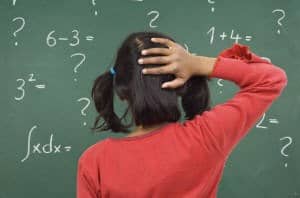Does your child need to learn effective study techniques? Today, we start a series of how to tips for helping your child study for tests in different subject matters. Each day we’ll introduce new tips for each subject. Let’s start with math.

Our daughter is in grade 4 and for the first time, she is having regular tests. Sure, we’ve been doing the weekly spelling tests since grade 1, but now she has regular tests across a wide range of subjects. It’s been an eye-opening year and one that’s had us reflect on the lack of focus on study skills.
Most teachers do not have the time to teach our kids good study techniques, as they spend the school days on teaching our children the actual subject matter. We certainly have had the wake-up call, when our child came home with a less-than expected score for a test – and we realize that it’s because she does not know how to study for a test.
If you are in the same boat and are looking for a checklist of things you can do with your child to teach them good study techniques, then read on…
Let’s start with studying for a math test. Math is for many kids the one subject that causes the most anxiety and a math test will elevate that fear of failure. There are many ways to revise for a test, and deploying many of these tactics will help to solidify your child’s preparation for their upcoming math test.
Understand the Process
Make sure that your child understands the core concepts and process for working out the correct answers. Take an example or two and have them work through it with you, explaining the process as they go.
Talk it Out/Work with a Study Partner
Have your child work with you or a study partner to review the major math concepts. Talk through the problems – let them take turns for each of the math problems.
Work it Out
Use flash cards, paper and/or “dry-erase” boards to work out the math equations. Find the questions from your textbook, find additional questions from the publisher’s extra resources (often found online) or turn to other online math resources for more questions. Repetition will help to drive home the math concepts.
Learn by Rote
Some math just needs to be learned by rote – for elementary school kids this would be their math facts. Use flash cards, math worksheets or online math facts learning resources for helping your child recollect the sums from memory, rather than working out the solutions on their fingers. Engage your kids in games, such as “beat the buzzer”. Have them complete a math worksheet within a specific amount of time – some kids rise to this occasion and others run out of the room in fear – so gauge this method by your child’s personality.
Add Color
When working through more complicated math problems, such as long division, have them use different colors for each step in the process. This will help them visualize and remember each step more clearly.
Draw it Out
Have your child in draw simple pictures to visualize problems involving shapes, sizes, distances or lengths. This will help them apply logic to what otherwise would only be expressed in numbers and words.
Is it Logical?
Teach your child to review their answers by logic. For example, if they are asked to find the speed of a car traveling between two distances and the answer is 800 mph – then the answer is incorrect.

